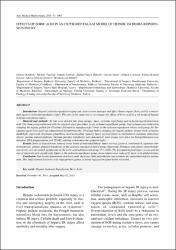Effects of boric acid in an experimental rat model of hepatic ischemia-reperfusion injury
| dc.contributor.author | Başbuğ, Murat | |
| dc.contributor.author | Yıldar, Murat | |
| dc.contributor.author | Yaman, İsmail | |
| dc.contributor.author | Özkan, Ömer Faruk | |
| dc.contributor.author | Akşit, Hasan | |
| dc.contributor.author | Çavdar, Faruk | |
| dc.contributor.author | Sunay, Fatma Bahar | |
| dc.contributor.author | Derici, Hayrullah | |
| dc.date.accessioned | 2019-10-25T07:28:21Z | |
| dc.date.available | 2019-10-25T07:28:21Z | |
| dc.date.issued | 2015 | en_US |
| dc.identifier.issn | 0393-6384 | |
| dc.identifier.issn | 2283-9720 | |
| dc.identifier.uri | https://hdl.handle.net/20.500.12462/9248 | |
| dc.description | Başbuğ, Murat (Balikesir Author) | en_US |
| dc.description.abstract | Introduction: Hepatic ischemia-reperfusion injury can cause serious damages and affect distant organs. Boric acid is a antioxidant agent in ischemia/reperfusion injury. The aim of this study was to investigate the effects of boric acid in a rat model of hepatic ischemia-reperfusion injury. Material and methods: 30 rats were divided into three groups: sham, ischemia reperfusion and ischemia-reperfusion+boric acid. The sham group underwent only the surgical stress procedure. In the ischemia-reperfusion group, liver ischemia was induced by clamping the hepatic pedicle for 45 minute, followed by reperfusion for 1 hour. In the ischemia-reperfusion +boric acid group, the therapeutic agent boric acid was administered intraperitoneally, 10 minute before clamping the hepatic pedicle. Serum levels of malondialdehyde, superoxide dismutase, glutathione, total antioxidant capacity, tumor necrosis factor-alpha, interleukin-6, aspartate aminotransferase, alanine aminotransferase, Gamma-glutamyl transferase were determined. Liver tissues were taken for histopathological examination, DNA fragmentation, and TUNEL staining to determine the apoptotic index. Results: Boric acid moderately reduced serum levels of malondialdehyde, tumor necrosis factor-alpha, interleukin-6. aspartate aminotransferase, gamma-glutamyl transferase in the ischemia-reperfusion injury group. Superoxide dismutase and alanine aminotransferase levels were decreased significantly in the boric acid-administered group (P < 0.05). The histopathological injury scores and the rate of apoptosis were significantly higher in the ischemia-reperfusion group; these injuries were reduced by boric acid administration. Conclusion: Our results demonstrate that boric acid decreases lipid peroxidation and enhances the antioxidant defense mechanism. This study showed that boric acid might protect against ischemia-reperfusion injury in this rat model. | en_US |
| dc.language.iso | eng | en_US |
| dc.publisher | Carbone Editore | en_US |
| dc.rights | info:eu-repo/semantics/openAccess | en_US |
| dc.subject | Hepatic Ischemia Reperfusion | en_US |
| dc.subject | Boric Acid | en_US |
| dc.title | Effects of boric acid in an experimental rat model of hepatic ischemia-reperfusion injury | en_US |
| dc.type | article | en_US |
| dc.relation.journal | Acta Medica Mediterranea | en_US |
| dc.contributor.department | Tıp Fakültesi | en_US |
| dc.contributor.authorID | 0000-0001-8200-1530 | en_US |
| dc.contributor.authorID | 0000-0001-5430-9917 | en_US |
| dc.contributor.authorID | 0000-0002-2231-7979 | en_US |
| dc.identifier.volume | 31 | en_US |
| dc.identifier.issue | 5 | en_US |
| dc.identifier.startpage | 1067 | en_US |
| dc.identifier.endpage | 1073 | en_US |
| dc.relation.tubitak | info:eu-repo/grantAgreement/TUBITAK/113S445 | en_US |
| dc.relation.publicationcategory | Makale - Uluslararası Hakemli Dergi - Kurum Öğretim Elemanı | en_US |
Bu öğenin dosyaları:
Bu öğe aşağıdaki koleksiyon(lar)da görünmektedir.
-
Cerrahi Tıp Bilimleri-Makale Koleksiyonu [636]
Surgical Sciences-Article Collection -
Scopus İndeksli Yayınlar-Makale Koleksiyonu [4974]
Article Collection -
Temel Bilimler-Makale Koleksiyonu [110]
Basic Sciences-Article Collection -
Temel Tıp Bilimleri-Makale Koleksiyonu [285]
Internal Medicine-Article Collection -
WOS İndexli Yayınlar-Makale Koleksiyonu [4952]
WOS Indexed Publications-Article Collection


















